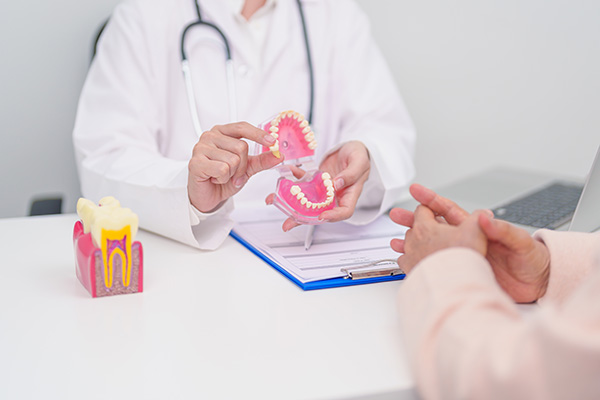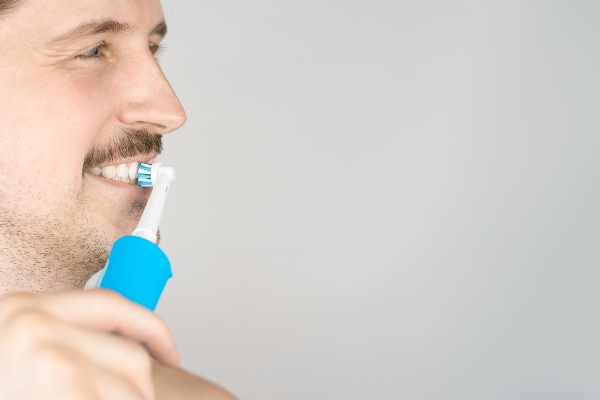What to Expect During An Oral Cancer Screening

Oral cancer screenings are a simple yet essential procedure that helps dentists look for signs of cancer in your mouth and throat. This quick and painless examination can catch signs of oral cancer in its early stages. If you have an upcoming oral cancer screening, here is what you can expect from the process.
An overview of oral cancer screenings
An oral cancer screening is an exam where dental providers look for signs of noncancerous or cancerous conditions in a patient's mouth. Oral cancer screenings are particularly important for individuals with risk factors such as:
- Smoking and other tobacco use
- Heavy alcohol consumption
- A history of human papillomavirus (HPV) infection
- Genetic syndromes (e.g., Fanconi anemia and dyskeratosis congenita)
- Excessive exposure to sunlight or artificial sunlight (tanning beds)
- Malnutrition
- Over the age of 55
However, regardless of their risk level, everyone can benefit from oral cancer screenings. Oral cancer can affect individuals with no apparent risk factors.
The importance of oral cancer screenings
Common types of oral cancer include mouth cancer, jaw cancer, and tongue cancer. It is a common head and neck cancer. According to the Cleveland Clinic, nearly 54,000 Americans are diagnosed with oral or oropharyngeal cancer each year. It has a 57% five-year survival rate, meaning that more than half of the people diagnosed with oral cancer are alive five years after being diagnosed.
While oral cancer is not particularly difficult to diagnose or treat, its fatality rates are high because it is diagnosed late in its development. Oral cancer does not typically present symptoms until it is in its advanced stages and goes unnoticed without a professional examination. Oral cancer screenings are the best tool for medical providers to use to help ensure early diagnosis and successful treatment outcomes.
Preparing for an oral cancer screening
No special preparation is needed before an oral cancer screening. Patients should maintain good oral hygiene and attend regular dental appointments. During their appointment, they should share their medical history, including any habits or conditions that could increase the risk of oral cancer. This information helps dentists tailor the screening process to the individual's needs.
What happens during an oral cancer screening
An oral cancer screening is typically quick, often taking less than ten minutes to complete. It involves visually and physically examining the patient's mouth and surrounding areas. Dentists can identify abnormalities or changes in the patient's tissues that warrant further testing. They can also use the findings to refer the patient to an oncologist or perform a biopsy to determine if the lesion is cancerous.
Visual examination
The dentist begins by visually inspecting the patient's mouth. They will typically examine the following areas:
- Cheek lining
- Floor and roof of their mouth
- Gums
- Lips
- Tongue
- Tonsils and throat
A small mirror or a light may be used to ensure better visibility of hard-to-see areas. Dentists look for discolorations, red or white patches, sores that do not heal, or any unusual lumps or thickened tissues.
Physical examination
After the visual inspection, the dentist performs a physical examination (palpation). This step involves gently feeling the patient's neck, jawline, and lymph nodes to detect the presence of swelling, tenderness, or lumps. They often move the patient's tongue with a gauze pad to view its sides and underside. These areas are where abnormalities are more likely to develop.
Oral cancer screening dye or light
Many dental providers use oral cancer screening tools like toluidine blue dye and screening lights to look for signs of oral cancer. They coat any visible lesions with the dye, which can detect areas that might become cancerous. If the dye stains the tissue, it may indicate the presence of oral cancer.
For an oral cancer screening light, the dentist will ask the patient to rinse their mouth with a fluorescent mouthwash. Then, they will shine a special light in the patient's mouth. The light makes healthy tissue look dark and abnormal tissue looks white.
What to expect if abnormalities are found
If the dentist detects any abnormalities during the oral cancer screening, they may recommend further testing. This might include a cytology or a biopsy, where a small tissue sample is collected and sent to a laboratory for analysis. The dentist may also refer the patient to an oral surgeon or oncologist for a more detailed evaluation.
It is important to remember that not all abnormalities indicate the presence of oral cancer. Many benign conditions can mimic the signs and symptoms of oral cancer. Early follow-up ensures that any issue is addressed promptly, whether it is cancerous or not.
Schedule an oral cancer screening today
Regular oral cancer screenings are an important part of preventive dental care. Whether you have risk factors or not, this examination can provide you peace of mind and, if necessary, lead to early treatment and improved recovery outcomes. Call New York our office to learn more or to schedule an appointment today.
Request an appointment here: https://www.newyorkdentaloffice.com or call New York Dental Office at (212) 548-3261 for an appointment in our New York office.
Check out what others are saying about our dental services on Yelp: Oral Cancer Screening in New York, NY.
Recent Posts
A general dentist professional would be the most obvious choice of people to go to get an oral cancer screening. Because your dentist has most likely seen you before, they will be able to screen your mouth without any issue.Since a lot of people are not educated on oral cancer screenings, the most common questions…
Most people have experienced seeing red on the bristles of their toothbrush, or a pink tint in the sink when they expectorate after brushing. It is normal to feel a bit of concern when noticing blood in the mouth because bleeding gums are a symptom commonly associated with gum disease. However, while chronic bleeding gums…
Bleeding gums are a symptom of poor gum health. Since you may not experience pain or discomfort, you may not think it is serious. In many, bleeding gums indicate gum disease. If left untreated, gum disease can lead to serious health complications.Gum disease develops when plaque and tartar buildup along the gumline causes inflammation. Over…
Flossing can seem like a chore, but the link between flossing and bleeding gums is clear. Sometimes, when you floss, you might occasionally find it causes your gums to bleed. That does not mean that flossing is bad for you — but you may not be doing it properly. Frequent flossing is the solution to…



